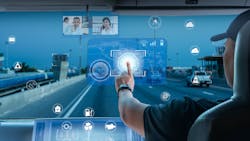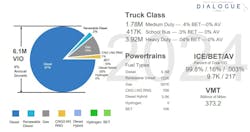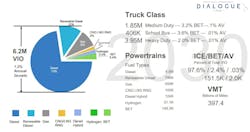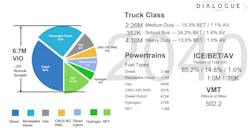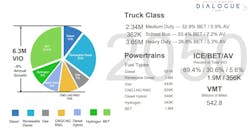GRAPEVINE—On Jan. 22, Derek Kaufman, managing partner of Schwartz Advisors, took to the Heavy Duty Aftermarket Dialogue at the Gaylord Texan Resort & Convention Center to offer the vehicle aftermarket consulting firm’s forecast for a mix of low-carbon or carbon-neutral fuels, near-to-zero emissions fuels, internal combustion engines (ICE) and full battery-electric (BET) solutions.
“We understand that runs counter to the EPA and [California Air Resources Board], who are pushing primarily BET solutions,” Kaufman noted. “But we think it's better representation of the technological reality of where we are today and therefore, a solid platform on which to build your parts and services.”
To do this, Kaufman broke his analysis into three times: present to 2030, 2030 to 2040, and beyond 2050. He included diesel, renewable diesel, gas, natural gases, diesel hybrids, hydrogen, and BET powertrains in his analysis of the medium-duty, heavy-duty, and school bus sectors.
2024 to 2030: ICE still dominates
First, Kaufman established the current powertrains in operation going into 2024. Of the 6.1 million vehicles in operation (VIO) that Schwartz Advisors counted, 5.3 million were diesel and 581,000 gas. Additionally, renewable fuel vehicles made up 2% of the overall assets and natural gas about 1%. Overall, ICE dominated the industry at 99.8% of the total VIO.
Meanwhile, the organization also found the amount of autonomous vehicles and BETs to be negligible going into 2024, with under 1% of school buses, medium-duty vehicles, and heavy-duty using battery-electric powertrains.
Kaufman noted that the lack of BETs could be due to how current regulations from CARB and the EPA outstrip infrastructure and manufacturer capabilities to create these vehicles. The same is true for natural gas resources, with the U.S.’s renewable volume obligations below renewable refineries current capacity.
“We think the industry now pushes back,” Kaufman asserted. “[It] pushes back against the EPA, pushes back against CARB to say, ‘Look, give renewables a chance to ramp here, to show that ICE can be a part of climate sustainability.’”
2030s: Shift to carbon neutrality
By the 2030’s, Kaufman anticipated that the VIO will grow to 6.2 million, with a decrease in diesel powertrains from 87% to 73% in the market. Meanwhile, gas vehicle powertrains are projected to remain consistent and renewable diesel will grow by 10%. The amount of BETs will increase to 3.2% for MD, 2% for HD, and 3.6% for school buses.
Read more: So many alt-fuel choices, but so little time?
“We believe that renewables ultimately beat biodiesel, we think it's a drop in fuel, we think it has a better chance of being carbon neutral going forward [in 2030],” Kaufman explained. “We also say BET sales are going to ramp, so our ramp to 30% is during the 2030s from 10 to 30% in sales.”
The Schwartz Advisors managing partner also emphasized that they were very encouraged by Cummins’ current work with hydrogen, and that they expect to see more 48V architectures due to diesel hybrids, as well as more battery swapping and Asian OEMs in the industry.
2040s: Rise of the self-driving truck
By 2040, Kaufman anticipated that vehicles in operation will reach 6.7 million, with AVs starting to become a real force in the market at 70,000 sold.
Additionally, he said that the role of data in repair, maintenance, and components is likely to rise, along with the trend of OEMs beginning to acquire their customers to offer autonomous transportation as a service.
“The reason is that they can't afford to lose their brands to autonomous trucks,” Kaufman explained. “We think that in this area, AV sales will grow from 4.3% to 11.7%. of sales.”
This decade could also see significant growth in BETs too. Per sector, Schwartz estimates the share of electric powertains will be:
- Medium-duty: 15.3%
- Heavy-duty: 13.6%
- School buses: 24.2%
Schwartz Advisors also expected to see greater ICE sustainability in this period and the full arrival of hydrogen powertrains.
“We believe that it takes a long time for hydrogen to become competitive, but by this time, all the infrastructure [is in place] and hydrogen is steamrolling the industry,” Kaufman stated.
2050s: Sustainable trucking reached?
Although 2050 is difficult to forecast with any certainty, Kaufman relayed how Schwartz Advisors expected the amount of VIO to drop almost 1% due to the growth of AVs in the next two decades, even as the number of vehicles with renewable powertrains expand. Among these, Kaufman estimated that BETs would be much more prevalent by 2050, making up 32.9% of medium-duty vehicles, 53.4% of school buses, and 26.8% of heavy-duty vehicles.
He also forecasted that component tracking would reach its peak, and that hydrogen, too, would be a full-fledged force in the industry, and that trucking would be fully sustainable at this point.
However, Kaufman cautioned that while these technological advances are possible and that manufacturers can work with agencies like the EPA and CARB to achieve them, that “government oversight can become government overreach” very quickly. As such, it’s up to the industry to ask for the time it needs to set up the necessary infrastructure.
“It's time for the people in this room to say that climate sustainability requires business sustainability,” Kaufman concluded.
About the Author

Alex Keenan
Alex Keenan is an Associate Editor for Fleet Maintenance magazine. She has written on a variety of topics for the past several years and recently joined the transportation industry, reviewing content covering technician challenges and breaking industry news. She holds a bachelor's degree in English from Colorado State University in Fort Collins, Colorado.
